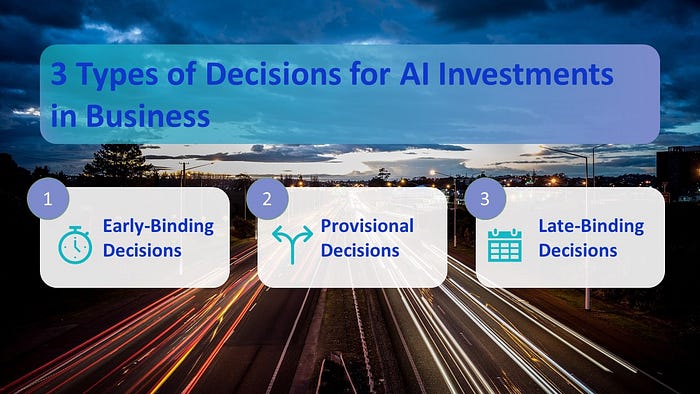
Integrating artificial intelligence (AI) and generative AI (genAI) into a business can be a thrilling but challenging process. Many business professionals understand the potential transformation AI can bring and the competitive advantage it may offer. However, due to the ever-changing nature of the technology, high expenses, and uncertainty regarding the best solutions and applications, business and technology leaders frequently face a difficult decision.
Should we take a bold approach and dive in headfirst, or should we proceed with caution and dip our toes in slowly? While it’s understandable to hesitate, this could cause us to miss out on opportunities and fall behind competitors.
Recently, while listening to “Founders at Work”, I was struck by a concept discussed by Ray Ozzie, the creator of Lotus Notes and former Chief Software Architect of Microsoft. He spoke about “late-binding” decisions — postponing decisions until the last responsible moment. This concept struck a chord with me, as it’s particularly relevant today. In the world of AI adoption, not all decisions need to be made immediately.
A Framework for Early, Late, and Provisional Decisions
This realization led me to propose a decision-making framework for AI adoption that categorizes decisions into three types: Early-binding, Late-binding, and Provisional.
Early-binding decisions
Early-binding decisions are those that can and should be made now. These decisions align with the company’s strategic objectives and current understanding of the market. Importantly, these decisions should not just be about integrating AI into existing systems and processes, but should also align with your long-term vision for how AI can bring about a step-change in your business. For example, a company might make an early-binding decision to invest in AI to improve customer service, based on current customer feedback and market trends. However, it’s crucial that these early-binding decisions are not forced and should not be filled only with the obvious ones. Decisions that fall into the provisional and late-binding categories should be thoroughly analyzed to determine if any aspects can truly be moved into the early-binding category without being forced.
Late-binding decisions
Late-binding decisions are those that we should defer until more information is available or until other enterprise readiness activities are completed. These decisions would benefit from further data, developments in the AI landscape, or advancements in your organization’s readiness to adopt AI. For instance, the choice of specific AI technologies could be a late-binding decision. With the rapid pace of AI development, a technology that seems cutting-edge today might be outdated in a few months. By delaying this decision, the company can ensure they are choosing the most relevant and advanced technology when the time comes to implement it. A crucial element of late-binding decisions is the ability to plan for the future capabilities of the technology, not just its current state. As Wayne Gretzky famously said, “Skate to where the puck is going, not where it has been.” This approach allows your organization to align its AI strategy with the future direction of AI technology, rather than being limited by its current capabilities.
Provisional decisions
Provisional decisions are those that we make now, with the understanding that we may need to revisit and possibly reinvest in them later. These decisions allow the company to move forward but with built-in flexibility to adjust as needed. It’s important to note that when making a provisional decision, a rough estimate should be made for when and how this decision will be revisited. An example of a provisional decision might be the selection of a technology vendor for your AI initiatives. Given the rapidly evolving AI landscape, you might choose a vendor that seems to offer the best solution at the moment. However, you do so with the understanding that the space is rapidly changing, and there might be better, cheaper, and more suitable vendors available in the future. The growth of open-source solutions in the AI field is another factor that could potentially alter this landscape. Therefore, this decision will need to be revisited at a later date.
This framework can be applied to various aspects of AI adoption, including but not limited to:
- Customer Engagement & Interactions,
- Products and Services,
- Marketing Strategy,
- Technology and Architecture,
- Talent and Skills,
- Operating Model,
- And more.
It’s important to note that this list is not exhaustive and may vary based on the specific needs and context of each company. It is a starting point for executives to consider where AI can be integrated into their organization.
Implications to Tech Companies
Marketing strategy is particularly crucial for tech companies, as the broad use of AI in their products and services can significantly impact market segments, positioning, pricing, and more. For instance, an early-binding decision in this area might be the commitment to use AI to analyze market trends and inform marketing strategies. A late-binding decision could be how to adjust your market positioning or pricing in response to competitors’ use of AI in their products and services. This decision could be deferred until you have a clearer understanding of the impact of AI on your market. A provisional decision might be to launch a pilot marketing campaign that incorporates AI-driven insights, with the understanding that the results of this campaign will inform future marketing strategies.
Similarly, in the area of products and services, an early-binding decision could be to integrate proven AI features into a product line, where in some cases the technology may not be ready. A provisional decision might be to launch an AI-enhanced version of a single product as a test case, with the understanding that the results of this test will inform future decisions.
How to Get the Most out of the Decision Framework
While the decision-making framework provides a mental model and is simple to use, its true power lies in its ability to align everyone in the organization. When all stakeholders understand and apply the framework consistently, it can significantly streamline the decision-making process and ensure that everyone is moving in the same direction.
To help you get the most out of this framework, here are a few tips on how to effectively use it:
- ⚖️Balance Your Decisions: Once you’ve categorized your decisions, take a step back and assess the balance. If you find that most of your decisions fall into the ‘late-binding’ category, it might indicate a level of hesitation or uncertainty. Try to break down these larger decisions into smaller ones that can be moved into the ‘early-binding’ category. This will help maintain momentum and progress.
- ☑️Regularly Review and Adjust: The categories of your decisions aren’t set in stone. As circumstances change and more information becomes available, ‘late-binding’ decisions might move into the ‘early-binding’ category, and ‘provisional’ decisions might need to be revisited. Regularly review your decisions to ensure they’re still in the right category.
- 🎙️Communicate Clearly: Make sure all relevant stakeholders understand each decision’s framework and status. This will help ensure everyone is on the same page and can contribute effectively to the decision-making process.
- ✍️Embrace Learning: Especially for ‘provisional’ decisions, view them as learning opportunities. Even if a decision doesn’t lead to the expected outcome, the lessons learned can inform future decisions and strategies.
- 🌎Consider the Big Picture: While this framework helps break down the decision-making process, it’s important to always consider the big picture. Each decision should align with your overall business strategy and objectives.
Remember, the goal of this framework is not to eliminate uncertainty but to manage it. Uncertainty is given in the rapidly evolving field of AI, but with this framework, you can navigate it strategically and make progress toward your AI adoption goals.


Leave a Reply